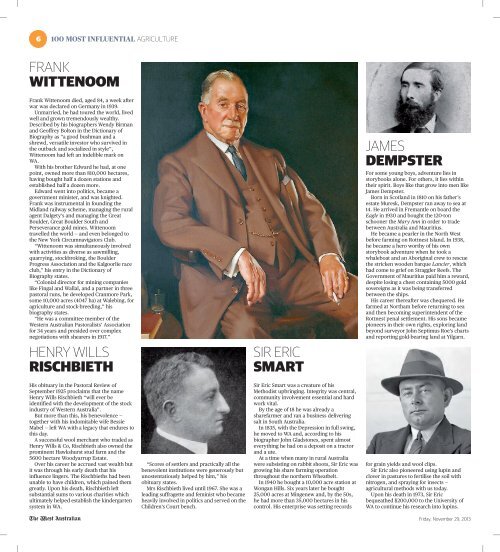Download This Feature
Download This Feature
Download This Feature
Create successful ePaper yourself
Turn your PDF publications into a flip-book with our unique Google optimized e-Paper software.
6 100 MOST INFLUENTIAL AGRICULTUREFRANKWITTENOOMFrank Wittenoom died, aged 84, a week afterwar was declared on Germany in 1939.Unmarried, he had toured the world, livedwell and grown tremendously wealthy.Described by his biographers Wendy Birmanand Geoffrey Bolton in the Dictionary ofBiography as “a good bushman and ashrewd, versatile investor who survived inthe outback and socialized in style”,Wittenoom had left an indelible mark onWA.With his brother Edward he had, at onepoint, owned more than 810,000 hectares,having bought half a dozen stations andestablished half a dozen more.Edward went into politics, became agovernment minister, and was knighted.Frank was instrumental in founding theMidland railway scheme, managing the ruralagent Dalgety’s and managing the GreatBoulder, Great Boulder South andPerseverance gold mines. Wittenoomtravelled the world — and even belonged tothe New York Circumnavigators Club.“Wittenoom was simultaneously involvedwith activities as diverse as sawmilling,quarrying, stockbroking, the BoulderProgress Association and the Kalgoorlie raceclub,” his entry in the Dictionary ofBiography states.“Colonial director for mining companieslike Fingal and Wallal, and a partner in threepastoral runs, he developed Cranmore Park,some 10,000 acres (4047 ha) at Walebing, foragriculture and stock-breeding,” hisbiography states.“He was a committee member of theWestern Australian Pastoralists’ Associationfor 34 years and presided over complexnegotiations with shearers in 1917.”HENRY WILLSRISCHBIETHSIR ERICSMARTJAMESDEMPSTERFor some young boys, adventure lies instorybooks alone. For others, it lies withintheir spirit. Boys like that grow into men likeJames Dempster.Born in Scotland in 1810 on his father’sestate Muresk, Dempster ran away to sea at14. He arrived in Fremantle on board theEagle in 1930 and bought the 120-tonschooner the Mary Ann in order to tradebetween Australia and Mauritius.He became a pearler in the North Westbefore farming on Rottnest Island. In 1938,he became a hero worthy of his ownstorybook adventure when he took awhaleboat and an Aboriginal crew to rescuethe stricken wooden barque Lancier, whichhad come to grief on Straggler Reefs. TheGovernment of Mauritius paid him a reward,despite losing a chest containing 5000 goldsovereigns as it was being transferredbetween the ships.His career thereafter was chequered. Hefarmed at Northam before returning to seaand then becoming superintendent of theRottnest penal settlement. His sons becamepioneers in their own rights, exploring landbeyond surveyor John Septimus Roe’s chartsand reporting gold-bearing land at Yilgarn.His obituary in the Pastoral Review ofSeptember 1925 proclaims that the nameHenry Wills Rischbieth “will ever beidentified with the development of the stockindustry of Western Australia”.But more than this, his benevolence —together with his indomitable wife BessieMabel — left WA with a legacy that endures tothis day.A successful wool merchant who traded asHenry Wills & Co, Rischbieth also owned theprominent Hawkshurst stud farm and the5600 hectare Woodyarrup Estate.Over his career he accrued vast wealth butit was through his early death that hisinfluence lingers. The Rischbieths had beenunable to have children, which pained themgreatly. Upon his death, Rischbieth leftsubstantial sums to various charities whichultimately helped establish the kindergartensystem in WA.“Scores of settlers and practically all thebenevolent institutions were generously butunostentatiously helped by him,” hisobituary states.Mrs Rischbieth lived until 1967. She was aleading suffragette and feminist who becameheavily involved in politics and served on theChildren’s Court bench.Sir Eric Smart was a creature of hisMethodist upbringing. Integrity was central,community involvement essential and hardwork vital.By the age of 18 he was already asharefarmer and ran a business deliveringsalt in South Australia.In 1835, with the Depression in full swing,he moved to WA and, according to hisbiographer John Gladstones, spent almosteverything he had on a deposit on a tractorand a ute.At a time when many in rural Australiawere subsisting on rabbit shoots, Sir Eric wasgrowing his share farming operationthroughout the northern Wheatbelt.In 1940 he bought a 10,000 acre station atWongan Hills. Six years later he bought25,000 acres at Mingenew and, by the 50s,he had more than 35,000 hectares in hiscontrol. His enterprise was setting recordsfor grain yields and wool clips.Sir Eric also pioneered using lupin andclover in pastures to fertilise the soil withnitrogen, and spraying for insects —agricultural methods with us today.Upon his death in 1973, Sir Ericbequeathed $200,000 to the University ofWA to continue his research into lupins.Friday, November 29, 2013
















